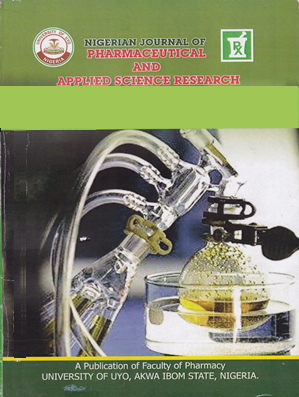Synthesis, Characterization and Antimicrobial Assessment of 3, 4, 5-Trimethoxy-3’, 4’-Dimethoxychalcone and 2, 4, 6-Trimethoxy-3’, 4’-Dimethoxychalcone
Main Article Content
Abstract
Background: Chalcones have been utilised in the synthesis of different heterocyclic molecules with antimicrobial activity.
Aims: This study aims to synthesise, characterise and screen 3, 4, 5-trimethoxy-3’, 4’-dimethoxychalcone and 2, 4, 6-trimethoxy-3’, 4’-dimethoxychalcone for antimicrobial property.
Methods: 3, 4, 5-trimethoxy-3’, 4’-dimethoxychalcone was synthesized from Claisen-Schmidt condensation reaction between 3, 4-dimethoxyacetophenone and 3, 4, 5-trimethoxybenzaldehyde in the presence of 50 % potassium hydroxide at room temperature and subsequently neutralised with 50 % acetic acid. Similarly, 2, 4, 6-trimethoxy-3’, 4’-dimethoxychalcone was produced through the reaction between 3, 4-dimethoxyacetophenone and 2, 4, 6-trimethoxybenzaldehyde in the presence of 50 % potassium hydroxide for 2 hrs at 70 oC and consequently neutralised by 50 % acetic acid. Purity was evaluated by melting point determination and thin layer chromatography (TLC). Characterization was done using UV and IR spectroscopy, 1HNMR, 13CNMR, Mass spectroscopy and Elemental Analysis.
Result: The compounds were screened for antimicrobial activity. 3, 4, 5-trimethoxy-3’, 4’-dimethoxychalcone was obtained as yellow crystal (melting point 121-122 oC, percentage yield 46 %) through the condensation reaction between 3,4-dimethoxyacetophenone and 3, 4, 5-trimethoxybenzaldehyde. While 2, 4, 6-trimethoxy-3’, 4’-dimethoxychalcone a yellow crystal (melting point 150-151 oC, percentage yield 41%) was synthesised by reacting 3, 4-dimethoxyacetophenone and 2, 4, 6-trimethoxybenzaldehyde.
Conclusion: Both synthesised chalcones do not have appreciable antimicrobial activity.
Downloads
Article Details

This work is licensed under a Creative Commons Attribution-NonCommercial-NoDerivatives 4.0 International License.
References
Zhao X, Dong WL, Gao YD, Shin D, Ye Q, Su L, Jiang F, Zhao BX and Miao JY. Novel indolyl-chalcone derivatives inhibit A549 lung cancer cell growth through activating Nrf-2/HO-1 and inducing apoptosis in vitro and in vivo. Sci. Rep. 7: 3919. DOI:10.1038/s41598-017-04411-3
[Susanti EVH and Setyowat EWA. A green synthesis of chalcones as an antioxidant and anticancer. International Conference on Chemistry and Material Science. Mat. Sci. Eng. 2017, 299: 1-6.
Rosa GP, Seca AML, Barreto MC, Silva AMC and Pinto DCGA. Chalcones and Flavanones Bearing Hydroxyl and/or Methoxyl Groups: Synthesis and Biological Assessments. Appl. Sci. 2019, 9. 2846.
Hsieh CT, Hsieh TJ, El-Shazly M, Chuang DW, Tsai YH, Yen CT, Wu SF, Wu YC and Chang FR. Synthesis of Chalcone derivatives as potential anti-diabetic agents. Bioorg. Med. Chem. Lett. 2012. 22, 3912-3915.
Perrin CL and Chang KL. The complete mechanism of an aldol condensation. J. Org. Chem. 2016. 81, 5631–5635.
Zhang J, Fu X, Yang N and Wang Q. Synthesis and Cytotoxicity of Chalcones and 5-Deoxyflavonoids. The Sci.W. J. 2013, 1-6.
Sashidhara KV, Palnati GR. Sonkar R, Avula SR, Awasthi C and Bhatia G. Coumarin chalcone ?brates: A new structural class of lipid lowering agents. Eur. J. Med. Chem. 2013, 64, 422–431.
Mahapatra DK, Asati V and Bharti SK. Chalcones and their role in management of diabetes mellitus: Structural and pharmacological perspectives. Eur. J. Med. Chem. 2015, 92, 839–865.
Rosa GP., Seca AML., Barreto MC., Silva AMS and Pinto DCGA. Chalcones and Flavanones Bearing Hydroxyl and/or Methoxyl Groups: Synthesis and Biological Assessments. Appl. Sci. 2019, 9, 2846; doi:10.3390/app9142846
Da Silva, G. and Domingues, S. We are never alone: living with the human microbiota. F.Y.M. 2017. 5. 35.doi:10.3389/frym.2017.00035.
Knobler, S.L., Lemon, S.L., Najafi A.L. (2003). The Resistance Phenomenon in Microbes and Infectious Disease Vectors: Implications for Human Health and Strategies for Containment: Workshop Summary. Washington (DC): National Academies Press (US); Microbe Resist. pp.2.
Holzmeyera, L., Hartigb, A., Franke, K., Brandtb, W., Muellner-Riehla, A.N, Wessjohannb, L.A., Schnitzlera, J. (2020). Evaluation of plant sources for anti-infective lead compound discovery by correlating phylogenetic, spatial, and bioactivity data. PNAS 2, 117. 22. 12444-12451. www.pnas.org/cgi/doi/10.1073/pnas.1915277117.
Babaiwa UF, Erharuyi O, Falodun A and Akerele JO. Antimicrobial activity of ethyl acetate extract of Citrullus lanatus seeds. Trop. J. Pharm. Res. 2017, 16(7), 1631-1636.
Nowakowska Z. A review of anti-infective and anti-inflammatory chalcones Eur. J. Med. Chem. 2007. 42. 125-137.
Asiri AM and Khan SA. Synthesis, characterization, and in vitro antibacterial activities of macromolecules derived from bis-chalcone, J. Het. Chem. 2012, 49. 1434-1438.
Ghani SBA, Weaver L, Zidan ZH, Ali HM, Keevil CW and Brown R. Microwave assisted synthesis and antimicrobial activities of flavonoid derivatives, Bioorg. Med. Chem. Lett. 2008, 18.18-522.
Furusawa M, Tanaka T, Ito T, Nishiwaka A, Yamazaki N, Nakaya KI, Matsuura N, Tsuchiya H, Nagayama M and Iinuma M. Antioxidant activity of hydroxyflavonoids. J. Health Sci. 2005, 51, 376–378.
Ahmad MR, Sastry VG, Bano N, Anwar S. Synthesis of novel chalcone derivatives by conventional and microwave irradiation methods and their pharmacological activities. Arab. J. Chem. 2016. 9, 1, S931-S935, doi.org/10.1016/j.arabjc.2011.09.002.
Zheng CJ., Jiang SM., Chen ZH., Ye BJ., Piao HR. synthesis and antibacterial activity of some heterocyclic chalcone derivatives bearing thiofuran, furan and quinolone moieties. Arch Pharm(weinheim), 2011,344(10):689-695.
Sivakumar PM., Priya S., Doble M. Synthesis, biological evaluation, mechanism of action and quantitative structure activity relationship studies of Chalcones as antimicrobial agents. Chem.Biol.Drug Des. 2009. 73(4):403-415
Xu M, Wu P, Shen F, Ji J and Rakesh K P. Chalcone derivatives and their antibacterial activities: current development. Bioorg. Chem. 103133. doi:10.1016/j.bioorg.2019.103133.
Amole KL., Bello IA and Oyewale AO. Synthesis, characterization and antibacterial activities of new fluorinated Chalcones. Chemistry Africa 2019.2.47-55.
Macaev F, Boldescu V, Pogrebnoi S, Duca G (2014) Chalcone Scaffold based Antimycobacterial Agents. Med chem 4: 487-493. doi:10.4172/2161- 0444.1000183
Mustikasari K and Santoso UT. The Benefit of Chalcones and its derivatives as antibacterial agents: A Review. Bio Web Conf. 20 (2020) 03007.


